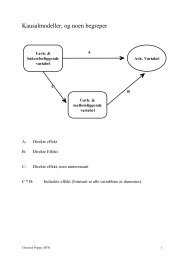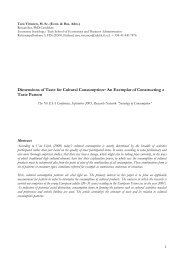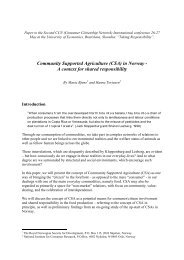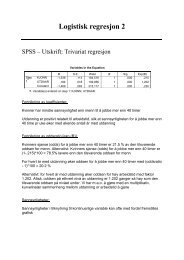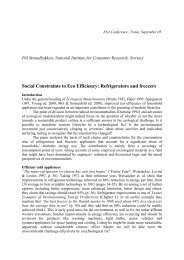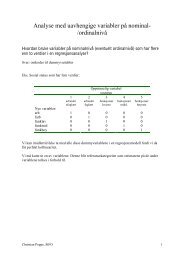an investigation of domestic laundry in europe - habits ... - SIFO
an investigation of domestic laundry in europe - habits ... - SIFO
an investigation of domestic laundry in europe - habits ... - SIFO
Create successful ePaper yourself
Turn your PDF publications into a flip-book with our unique Google optimized e-Paper software.
Assessment <strong>of</strong> the consumer <strong>laundry</strong> <strong>habits</strong> - a qu<strong>an</strong>titative survey 3310090807060504030201005 24 16 37281592831274461526033Greece Netherl<strong>an</strong>ds Norway Spa<strong>in</strong>5 times or more4 times3 timesTwiceOnceFigure 2-11. Frequency <strong>of</strong> ch<strong>an</strong>g<strong>in</strong>g a synthetic blouse or shirt <strong>in</strong> different countries. Percent.Synthetic fabrics are <strong>of</strong>ten delicate, <strong>an</strong>d this is reflected <strong>in</strong> the way they arewashed. Almost every household <strong>in</strong> the survey had its own wash<strong>in</strong>g mach<strong>in</strong>e,<strong>an</strong>d most <strong>of</strong> the <strong>laundry</strong> is done <strong>in</strong> the wash<strong>in</strong>g mach<strong>in</strong>e. But m<strong>an</strong>y householdsseem to prefer to wash their synthetic blouses <strong>an</strong>d shirts by h<strong>an</strong>d. This ismost common among the Greek respondents (17 %) <strong>an</strong>d <strong>in</strong> Spa<strong>in</strong> (14 %). Therespondents from the Netherl<strong>an</strong>ds seem to be less <strong>in</strong>cl<strong>in</strong>ed to wash their syntheticblouses <strong>an</strong>d shirts by h<strong>an</strong>d (7 %), <strong>an</strong>d <strong>in</strong> Norway this is only slightlymore common (9 % report launder<strong>in</strong>g these items by h<strong>an</strong>d).Even though the way it is washed seems to <strong>in</strong>dicate that synthetic fabric ismore delicate, there are few respondents except <strong>in</strong> Spa<strong>in</strong> who report that theylaunder these items <strong>in</strong> cold water. 55 % <strong>of</strong> the Sp<strong>an</strong>ish respondents wash theirsynthetic fabrics <strong>in</strong> cold water. The strongest tendency to use somewhatwarmer water is <strong>in</strong> Greece <strong>an</strong>d Norway, but the temperature used is seldommore th<strong>an</strong> 40 °C. This pattern is the same as we have seen earlier.2.4.6 Th<strong>in</strong> woollen sweatersAlmost all the respondents seem to have at least one th<strong>in</strong> woollen sweater.Th<strong>in</strong> woollen sweaters are delicate <strong>in</strong> the sense that wool gets damaged veryeasily <strong>an</strong>d shr<strong>in</strong>ks if it is washed too vigorously or <strong>in</strong> water that is too hot.Figure 2-12 reveals that the same pattern repeats itself. It is the respondentsfrom Spa<strong>in</strong> <strong>an</strong>d the Netherl<strong>an</strong>ds that are most likely to wash their sweatersafter a s<strong>in</strong>gle use. A larger percentage <strong>of</strong> the Norwegi<strong>an</strong> <strong>an</strong>d Greek respondentsquote that they use a th<strong>in</strong> woollen sweater several times before wash<strong>in</strong>git. 29 % <strong>of</strong> the Norwegi<strong>an</strong> respondents say they use it five times or more.




